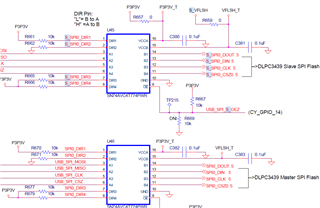Other Parts Discussed in Thread: DLP4710EVM-LC, DLPC3479, DLP4710, DLPA3005, DLPC900,
Tool/software:
Dear
I am reviewing DLP4710EVM-LC reference schematic and data sheet to develop 3d scanner.
I’m sorry for asking so many questions.
[Q0] In the reference schematic, it seems that only the Trigger0/1 of the Master beam is available. When capturing in Camera Trigger Mode, is it sufficient to use only the Master DLPC3479?
[Q1] The USB SPI is connected to both the Master SPI and Slave SPI through resistors.
In this configuration, it seems like there might be a conflict with the SPI signals from the DLPC3479. Is it possible to proceed with downloading data in this setup? Could you explain theoretically?
[Q2]To use the same circuit as the TI EVM for downloading, are there any considerations we need to take into account when controlling the DLPC3479 or when developing our own download program?
[Q3] When using the USB SPI for downloading, would it be acceptable to completely separate the Master and Slave SPI signals, or would this approach be problematic?
Would a circuit like the one attached function correctly?
[Q4] The Master DLPC3479 and Slave DLPC3479 share a common Parallel Bus. How is the display sequence managed in this setup? Are there any documents or materials explaining this?
-. 2Page
[Q5] Is the firmware downloaded via SPI different for the Master SPI Memory and the Slave SPI Memory?
[Q6] I understand that firmware for the DLP4710, DLPC3479 Master, DLPC3479 Slave, and DLPA3005 can be created on the TI site. Could you please explain the process?
[Q7] After downloading the firmware to the SPI Memory, is it possible to read the firmware version? I couldn’t find this information in the programming guide.
[Q8] In External Pattern Mode, after stopping operation, is it possible to change the exposure time and frequency (Hz) set via download by using I2C from the host, and then operate with the updated exposure time and frequency?
[Q9] What is pattern Ready signal? 4Page
[Q10] What is the lowest frequency input for a 1-bit signal in External Pattern Mode? Does 1Hz work as well?


